ALLIGATOR
BEHAVIOR page 4i: FEEDING page 9 page 1 2 3 4 5 6 7 8 10 11
This
page was born 8/19/2022. Rickubis designed it. (such as
it
is.) Last update:
Images
and contents on this page copyright ©2001-2022 Richard M.
Dashnau
Alligators favor prey
items that will fit inside their head. That
is, if they can swallow it
whole, then they will normally attack it. Alligators sometimes
eat deer
in the park, but the
larger ones were probably found carcasses, but small fawns
might have been live captures. Alligators
have eaten large nutria (as I've shown on this website). But,
most of
the time, they will
eat things like fish, frogs, crayfish, snakes....
Their strong jaws make alligators well-adapted for
eating turtles. Prey can be almost any size relative
to the size of the alligator. I've seen 10-foot
alligators going
after prey that was no larger than their largest teeth (very
small frogs
and fish). During 20 years of volunteering
at
Brazos Bend State Park, I've gathered many photos and video
clips
documenting how alligators survive in a natural environment.
This is
the latest page collecting
feeding behaviors.
From
Brazos Bend State Park on 06/19/2022
The recent drop in water levels in the park, although
unfortunate, has caused an increase of animal activity as they
adjust
to the new conditions. Starting in May, 2022- there were
increased
opportunities to view interesting behavior. One is an alligator
behavior I have called "seining" soon after I first
noticed it in 2002 (noted on this page; then later mentioned on this page;
and observed in the background of this video. I've seen alligators do
it many times, but haven't tried to fully
describe
again...until now. I filmed this material June 19, 2022, while
there
was still quite a bit of water in Pilant Lake, and along the
Spillway
Trail. This was filmed near the Spillway Bridge
For about an hour, I
watched this alligator as it did "seining" (horizontal body
movement
towards shallow water to trap prey) along with some other
related
activities. After years witnessing this
kind of behavior , I surmise
that all of these movements are done in an effort to
flush, herd,
and trap prey along shorelines (normally shallower) and in cuts
or
inlets along the bank. Part of the
reason I haven't described it
until now is that the activity is relatively subtle, and
difficult to
show with text and images (at least for me); but I watched this
alligator repeatedly follow these steps
for an hour, and
I've been able to pull many images from the video.
So, I'm
going to try it here. For the best view of this, I recommend
watching
the 8 minute video.
So
here we go. For this description, I'm going to start with
"underwater movement"; but the steps are done in a repeated
cycle (most
of the time, with some variation) so any step would work
as a starting point.
01)
Alligator moved while submerged, curving rapidly and using the
tail
both for propulsion and to stir the water. 02) Gator turned the
other direction (essentially moved in an "S"
pattern) and pushed
the submerged tail the other way--but only caused turbulence, it
did not move.
03) Gator walked (in the water) while using tail thrust not to
swim, but
cause more water
movement. Current and eddies began forming.



STEP 1
STEP 2
STEP 3
04) Gator moved toward one bank
(walking) with tail and body straight. 05)
Gator curved the front of body towards one side while shifting
body sideways in the opposite direction towards
that bank. 06) Body straightened as it shifted toward the
bank, tail was brought
around to push water towards the bank. Also sometimes front leg
near
bank was "waved" forward, which also
pushed water.



STEP 4
STEP 5
STEP 6
07),08)
Gator started "walking sideways" towards the bank while its tail
started low
oscillation, pushing water (but not pushing the gator).
09) Sidestepping increased in speed (pushing water
with the gator's side) while tail
oscillation increased, pushing more water.



STEP 7
STEP 8
STEP 9
10),11) Gator quickened sidestepping towards the bank (still
about 1 yd away), tail wass bent so the
end "half" oscillated quickly, pushing water, and pushing
the
hindquarters to swing
towards
that bank. 12) Body was nearly parallel to the
bank, tail was bent so the end was pointed forword, then tail
was
forced back and straightened, forcing more water to the
rear.
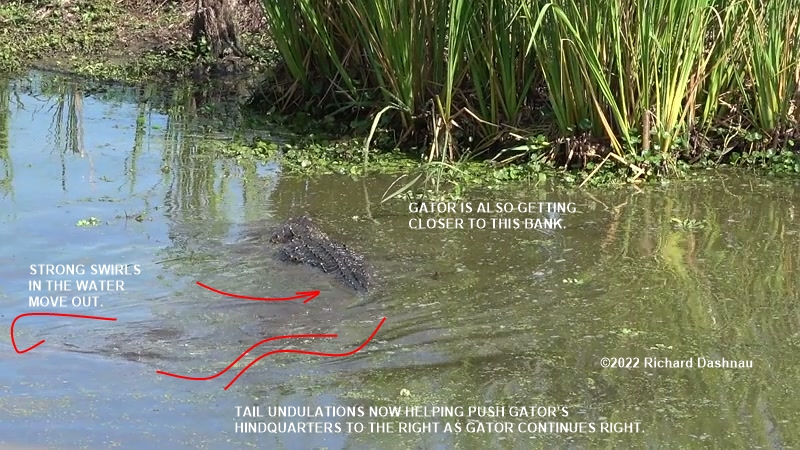


STEP 10
STEP 11
STEP 12
13) Gator
continued movement towards bank as strong tail waves forced
major
movement of water. Visible current now flowed past side of gator
that faced away from the bank. 14) As water
on the outside moved back,
displacement forced water between the bank and the gator
to move towards the gator's front.
Gator paused (possibly monitoring flows for prey).
15) Gator
started moving backwards,
still parallel to-and moving
towards-the bank with lesser tail undulations (which could serve
to
flush prey as well as keep water moving).
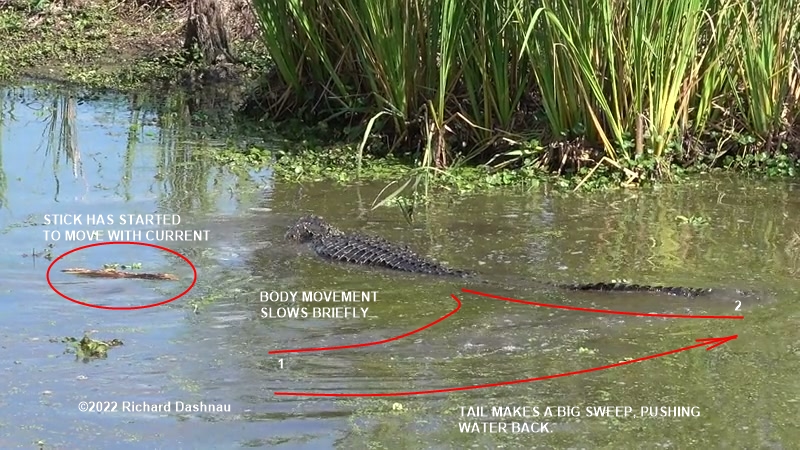


STEP 13
STEP 14
STEP 15
16) Movement slowed, then
paused, with an occasional head-twist (top towards the bank)
with
open jaws to catch whatever might be there. 17) Then continued
moving backwards and towards
the bank with more tail movement until... 18) ...gator
is either at the water's edge.
Along the way, gator put its face into the vegetation (possibly
using
ISOs on face to find prey), with
occasional grabs. There was no evidence (chewing,
swallowing, etc.) the the gator had actually caught anything.
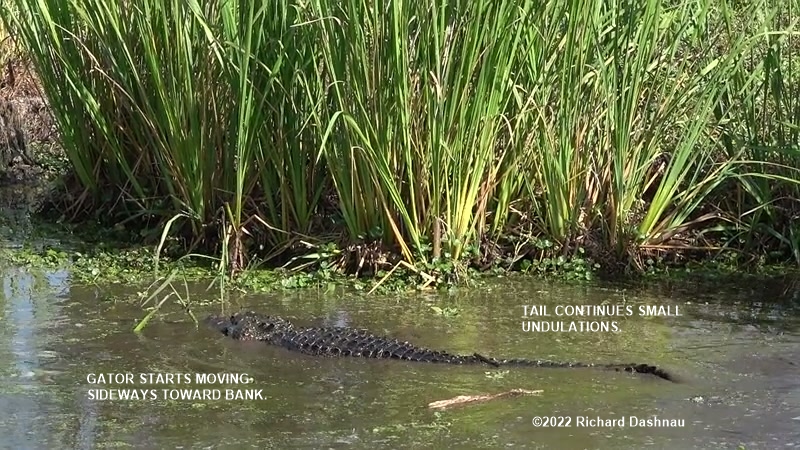


STEP 16
STEP 17
STEP 18
19) When the
gator reached the shore it paused; 20) 21) then
started moving backwards, and stayed close to the bank.



STEP 19
STEP 20
STEP 21
22)
While moving backwards, the gator paused for more grabs into the
plants. 23) 24) The gator moved until it was across a
small "gap"
in the bank, then moved sideways while blocking it.
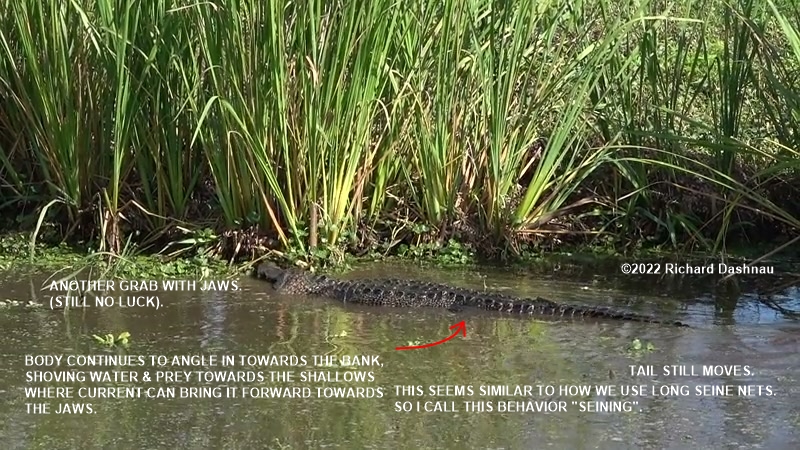


STEP 22
STEP 23
STEP 24
25,26)
The gator paused across the gap, moving the end of the tail, and
prospecting in the plants, until it turned and moved back to the
deeper
water to start another cycle.
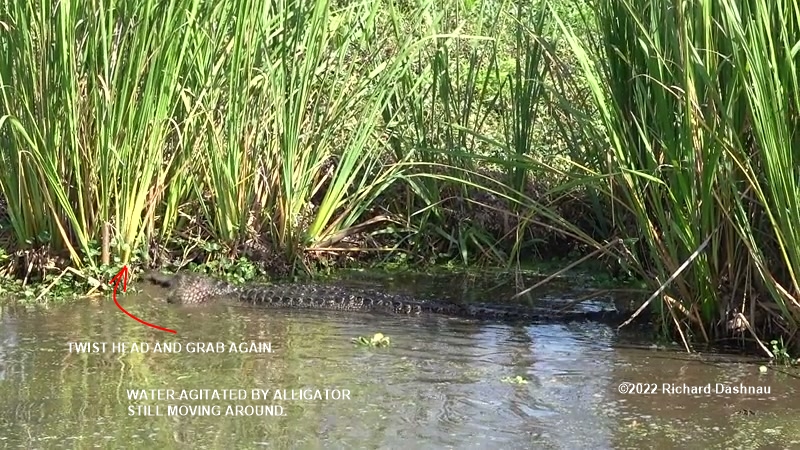


STEP 25
STEP 26
STEP 27
(step
27-above right through 34) While I was
watching this gator, another one performed a head-slap (which I
didn't
see, but I could certainly hear) about 4 yards away from the
first one.
I pulled focus back to watch for any further challenge.
While I watched the 2nd
gator, the first one rushed into movement, and I caught just the
end. It chased something towards the cutgrass.
29), 30), 31), 32) Then the
prey leaped out from the grass and escaped. It was a
Bowfin (amia
calva)! Amazing escape by twisting through the cutgrass!
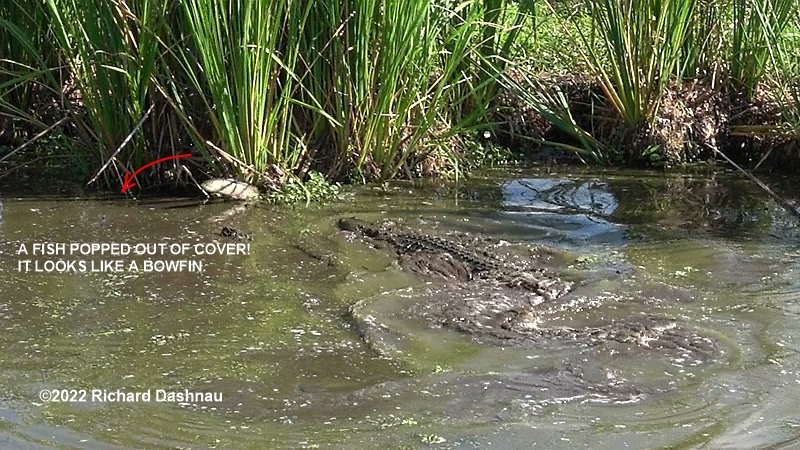


STEP 29
STEP 30
STEP 31
33,34)
The alligator gaped, apparently ready to lunge again, but then
stopped and went back to its survey. Meanwhile, I lost track of
the 2nd
alligator. I watched this alligator for an hour, hoping to
record
it catching something--or flushing something else exciting. But
we were both unlucky. I moved on. Once again, you can watch
the
8 minute video,which really demonstrates
the activity.



STEP 32
STEP 33
STEP 34
I've
watched "seining" behavior--moving sideways to herd prey towards
a
gathering point, in many different situations-not necessarily in
during
dry spells. I've also seen that alligators will
face upstream when
there is an observable current (such as water flowing over the
Spillway), to wait for prey. What I'm showing here seems to be a
combination of the two, with the
alligator generating the
current.
I have witnessed this before, and it requires the body of water
to be
shallow, and small enough for the behavior to generate at least
a brief
current.
Because of the scale of the events (yards across); and
their subtle nature (the current doesn't last long, and isn't
very
strong); it has been hard for me to record through video and/or
photos
in
a manner that would allow me to show how it works. I
believe I
was finally successful. I think the edited video works very
well,
better than the photos alone. Watch
the
8 minute video.
And,
this
page shows alligators at the park, on land, near various landmarks
at the park.
Go back to my main alligator
page, Alligators
Go
back to my home page, Welcome
to rickubis.com
Go
to the main
alligator page
































